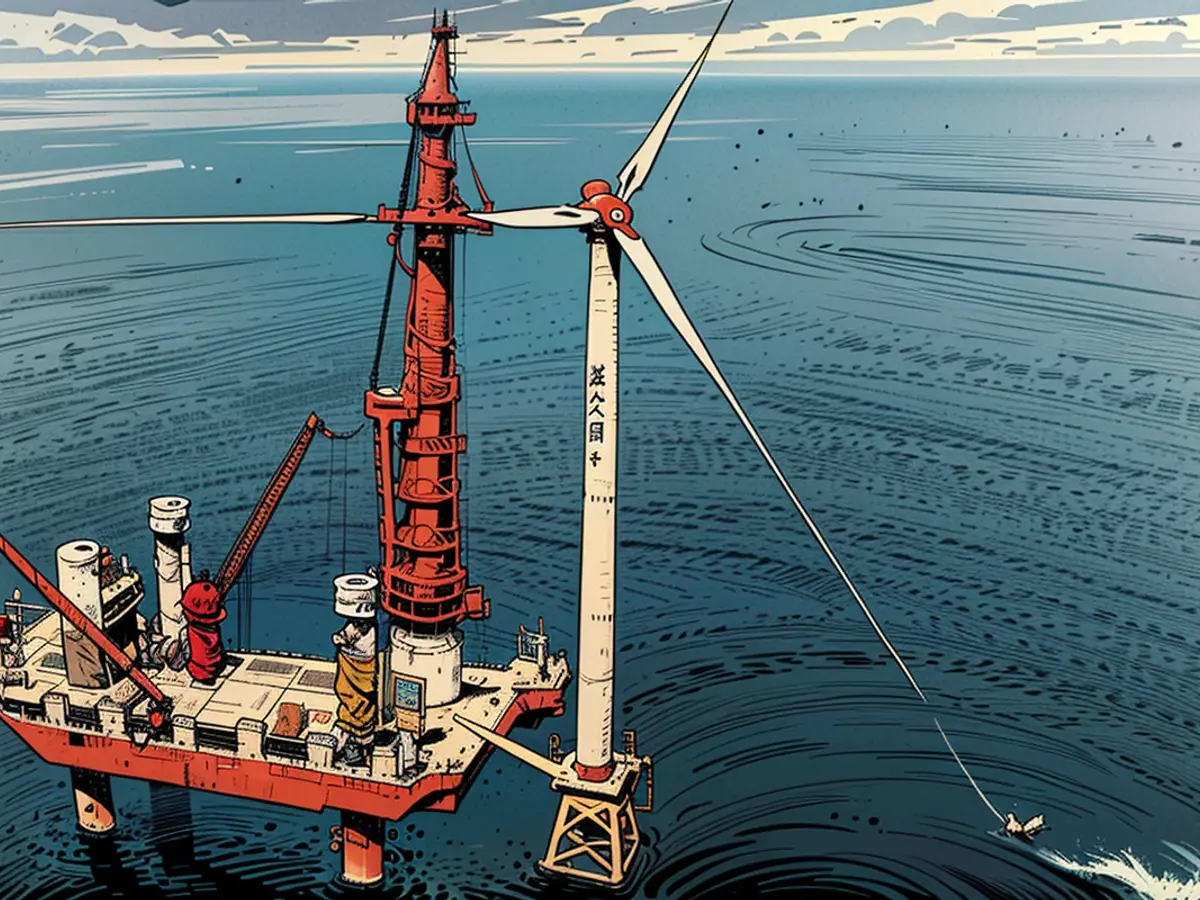16 Chinese wind turbines cause panic in Germany
In the North Sea, a wind farm with Chinese turbines is set to be built for the first time. Industry associations are not thrilled: They warn of unfair competition and Chinese control over Europe's power supply. However, there is likely no alternative.
The Waterkant wind farm, about 90 kilometers off Borkum in the North Sea, will be unique. From 2028, 16 turbines will generate green energy for around 400,000 households. Waterkant will be equipped with the world's largest and most powerful wind turbines: The 18.5-megawatt giants tower about 160 meters above the sea. The three rotor blades together have a diameter of 260 meters and are well-equipped for the extremely stormy North Sea: They are designed to withstand typhoons of category 17, which have wind speeds of up to 220 kilometers per hour.
"The decision for the most powerful offshore wind turbine in the world enables us to drive the energy transition in Germany forward and simultaneously promote the urgently needed competition in the industry," says Luxcara GmbH about the preliminary contract. It is developing the Waterkant wind farm.
However, the European wind industry is not enthusiastic. Industry associations warn of unfair competition that could end up like the solar industry. Particularly harsh critics say that the project even threatens European energy security. The reason: The manufacturer of the giant wind turbines is the Chinese company Ming Yang Smart Energy.
A strategic sector
Germany has ambitious goals for offshore wind power. Germany's current offshore capacities are around 9 gigawatts, equivalent to about nine large nuclear power plants. The traffic light coalition wants to more than triple them to 30 GW by 2030. To do this, more than 1000 new wind turbines need to be installed in the North and Baltic Seas. A huge number, but the European wind industry association WindEurope is convinced that European manufacturers like Siemens Gamesa, Vestas, and Nordex can meet this demand.
"The European offshore supply chain has been and is ready to deliver turbines made in Europe," explains WindEurope CEO Giles Dickson to the economic portal Bloomberg. "The European Union, Germany, and all other countries building offshore wind farms must decide whether wind energy is a strategic sector before it's too late." According to Dickson, the awarding of contracts is not just about economic reasons, but about European energy security.
Red button in China?
Wind turbines usually have around 300 sensors that collect important data. This data is needed so that manufacturers can identify and repair faults on the turbine. It also serves to control the performance of a wind turbine and, for example, adjust the angle of the rotor blades to always generate the optimum amount of power and not break in a storm. Manufacturers can also lock the wind turbines, which only happens when the power grid is overloaded.
"I don't want to imagine a world where China can take German wind turbines off the grid," warns Bärbel Heidebroek, president of the German Wind Energy Association (BWE), in the ntv podcast "Klima-Labor". "If you imagine that only Chinese wind turbines are standing in Germany, China - to put it bluntly - could press a red button and it would be dark. That's why we need clear rules like in telecommunications: China should not dominate and control this. The same should apply to cybersecurity for wind turbines."
Decision saves a lot of money
Why Luxcara chose Chinese over European wind turbines, the company does not wish to elaborate: An interview request from ntv was declined by the responsible parties, despite the calculation being particularly economically straightforward.
Ming Yang builds the world's largest wind turbines, and in wind power, the rule is: the bigger, the better. Larger wind turbines generate more electricity and bring in more money for operators. Therefore, the industry has been pushing all manufacturers for years to design increasingly larger installations.
According to Ming Yang, a wind farm also becomes cheaper when equipped with larger turbines. The Chinese manufacturer's calculation is as follows: Building a 1-gigawatt wind farm with the massive 18-megawatt installations costs $120,000 to $150,000 less per megawatt than if the wind farm had been built with smaller 13-MW installations.
Project developers like Luxcara also save further costs because Chinese wind turbines are generally much cheaper. They cost up to 50 percent less than comparable turbines from Europe, as the industry association WindEurope states, due to "unfair state subsidies" that could lead to the European wind industry facing a similar fate as the solar industry: Chinese manufacturers flooding the market and driving competitors out of business with their price war. The EU Commission is already investigating anti-dumping duties for Chinese manufacturers.
Not the Last Ones
Lastly, European manufacturers, unlike what WindEurope presents, are still struggling with limited capacities and need to ramp up their production. Even if the industry grows as planned from the current 300,000 employees to over 500,000 by 2030, it seems unlikely that it can cover the European demand alone. The EU wants to almost double the onshore and offshore wind capacity from the current 220 GW to 425 GW. Even if only the currently largest installations were used, that would mean at least 10,000 new wind turbines that would have to be installed in just five and a half years.
"We are the first, but we will not be the last to commission Chinese manufacturers," says Luxcara CEO Alexandra von Bernstorff in the "Handelsblatt". "There is simply no other way, only with the help of Chinese companies can the high demand be met." Safety concerns then take a back seat.
Despite Luxcara's decision to use Chinese wind turbines for the Waterkant project, concerns about unfair competition and potential Chinese control over Europe's power supply remain. European wind industry associations, such as WindEurope, believe that European manufacturers like Siemens Gamesa, Vestas, and Nordex have the capacity to meet the increased demand for offshore wind turbines.








